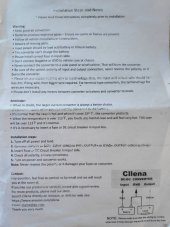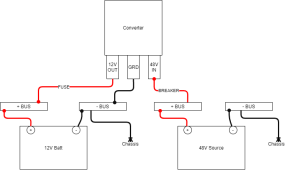RollingThunder
New Member
- Joined
- Feb 24, 2021
- Messages
- 58
Hi all,
On my RV I have had my solar and 48v 280ah lifepo4 system with a Growatt running for a week now with no problems. The old 12v lead acid batteries for the engine and house are still in place. I plan to remove the old house battery, leaving only the engine battery.
For 12 volt charging/loads, the power goes from the Growatt to the old MagnaTek power box, where the AC is converted to DC and goes to the DC fuse panel. All is working well there, too.
The next thing I want to do is use a 48v to 12v buck converter to power all the 12v devices directly off the battery. I bought a 60 amp 48v-12v converter, but the instructions state 'do NOT connect the converter ground to the chassis'. I assume that is because it has a common ground between the 48v and 12v side. It has only three terminals, the 48v pos, the 12v pos, and the common ground. The 48v system is not grounded to the chassis. It only exists between the growatt and the battery.
As a test, I disconnected the Magnatek's converter wires from the breaker to disable it, then wired the new converter to the posts which run to the lead acid house battery, to see if it would work. As I suspected, it did not, as the circuit is not complete, since the converter is not grounded to the chassis, if I am correct.
What can I do to make it work, other than running new ground wires from all devices back to a common ground for the buck converter? Is there some device I can use to allow the converter to connect to the chassis?
On my RV I have had my solar and 48v 280ah lifepo4 system with a Growatt running for a week now with no problems. The old 12v lead acid batteries for the engine and house are still in place. I plan to remove the old house battery, leaving only the engine battery.
For 12 volt charging/loads, the power goes from the Growatt to the old MagnaTek power box, where the AC is converted to DC and goes to the DC fuse panel. All is working well there, too.
The next thing I want to do is use a 48v to 12v buck converter to power all the 12v devices directly off the battery. I bought a 60 amp 48v-12v converter, but the instructions state 'do NOT connect the converter ground to the chassis'. I assume that is because it has a common ground between the 48v and 12v side. It has only three terminals, the 48v pos, the 12v pos, and the common ground. The 48v system is not grounded to the chassis. It only exists between the growatt and the battery.
As a test, I disconnected the Magnatek's converter wires from the breaker to disable it, then wired the new converter to the posts which run to the lead acid house battery, to see if it would work. As I suspected, it did not, as the circuit is not complete, since the converter is not grounded to the chassis, if I am correct.
What can I do to make it work, other than running new ground wires from all devices back to a common ground for the buck converter? Is there some device I can use to allow the converter to connect to the chassis?





